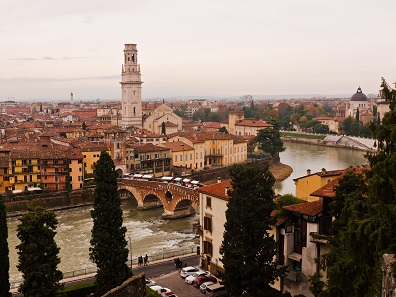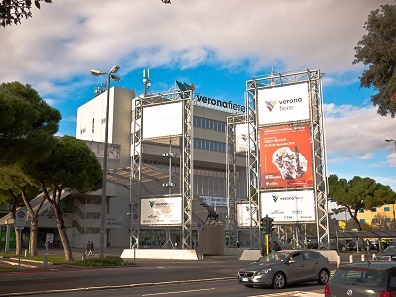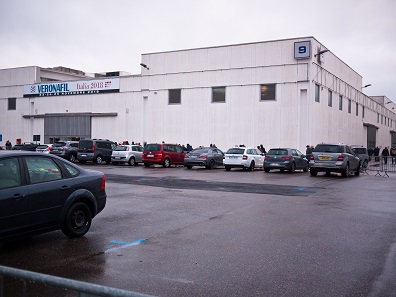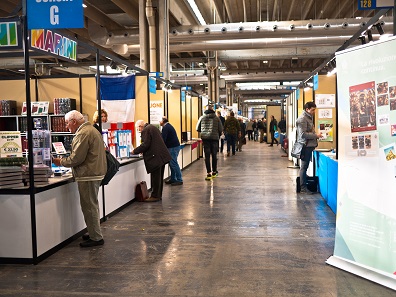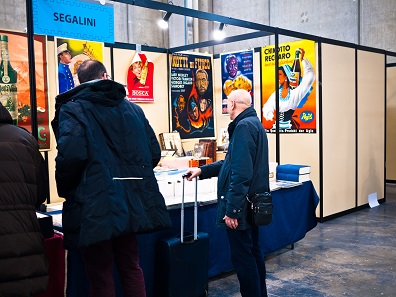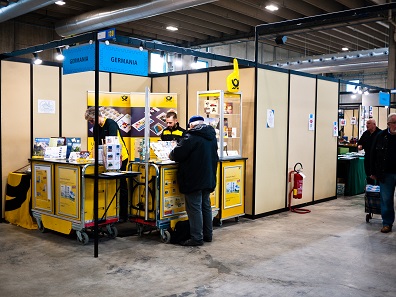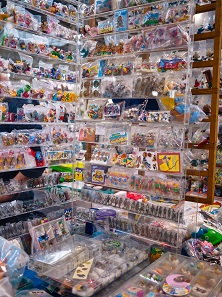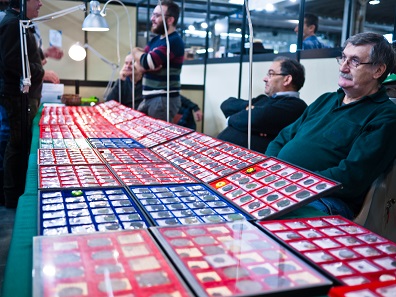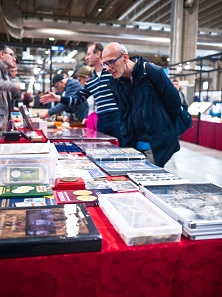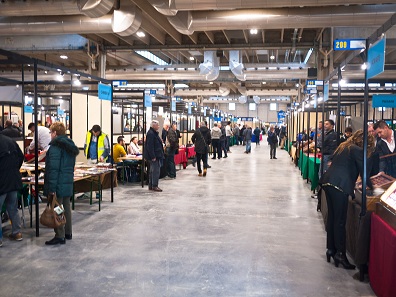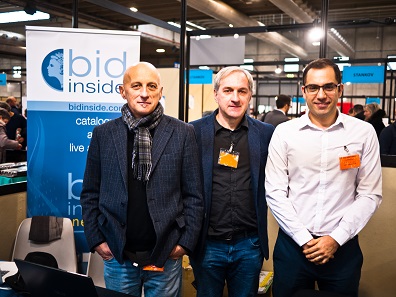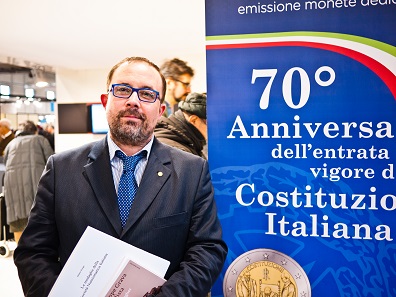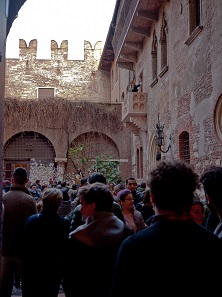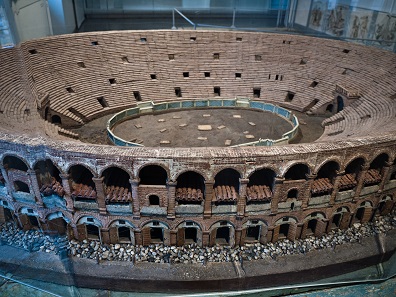Written by Björn Schöpe
Translated by Leonie Schulze
December 13, 2018 – Anyone who first thinks of Romeo, Juliet, and the opera at the amphitheater when they hear Verona, most likely isn’t a numismatist. The first thing that comes to a coin collector’s mind is Veronafil, Italy’s biggest convention of numismatics and philately.
This year, I decide to finally see the 131st edition of this convention and, of course, Verona for myself. Yet, it is common knowledge that there is no gain, without pain – and I experience that firsthand earlier than expected.
Even during fall, Verona has its very own charm. This is a view of the massive cathedral and the Ponte Pietra, which spans the Adige river. Photo: BS.
Back to where I started before it’s even begun
As I get off the train at Porta Nuova station with a delay of 25 minutes, cold sweat is already dripping off my forehead. I’ve just realized that my hotel expects me to pay by credit card. But I’ve left that one at home. While I’m pondering whether the Railway Mission or the police are the right ones to approach about this matter, I begin to get nervous. I’m generally known for being organized and well-prepared. But as I find myself walking down the streets of Verona without a map or a phone with internet access; I must admit that I’ve completely overestimated my memory.
As romantic as the old town of Verona is – you quickly become distracted when you have to carry a heavy bag through the night. Photo: BS.
So, I wander around aimlessly looking for my Bed&Breakfast with a constant drizzle accompanying my every step. At a random food cart, I ask for directions. The man is stumped for an answer. Ten meters down the road, a tourist map tells me I’m already on the right street. It seems as though the cart owner thought globally rather than locally … And after a nice conversation, I can of course pay cash for my room (thank you Cristiano!). Finally, there is nothing left holding me back from attending Veronafil.
Other events rely more insistently on advertising. Veronafil apparently doesn’t have to do that. Photo BS.
Coins and more
The venue isn’t hard to find. Veronafil itself, however, is a little more hidden. Any attempt at finding posters advertising the event prove futile. But then I discover more and more people walking towards the entry denoted “San Zeno”. And I soon realize: this is where I’m supposed to be.
You can feel the excitement building. At 9 a.m. sharp, the crowds enter the venue. Photo: BS.
At 9 a.m., the venue’s gates open. It’s about time. The convention’s visitors had already begun champing at the bit.
This is the first sign indicating that visitors have found the right building: Veronafil 2018. Photo: BS.
We rush across the giant parking lot towards the convention hall, where the realm of coins awaits us.
No coins in sight. Have I really found the right hall? Photo: BS.
The event has begun – but I have a feeling I’m at the wrong convention. I can’t see a single coin. (And I couldn’t find a map of the convention hall or an information desk either.)
Alcoholic beverages, trips, and movies – this is what was advertised in the Fifties. Photo: BS.
I can see a bunch of movie posters, historical post cards, and advertisements for Campari, city tours, or the brand-new 1950s Vespa.
Veronafil is equally important for Italian philately and numismatics alike. Photo: BS.
While Veronafil is famous for its numismatic offers, it shouldn’t be reduced to just that. Philately, too, is very well represented – even the Deutsche Post.
We shouldn’t judge what people collect. One man’s decadrachm is another man’s … uhm … plastic bears. Photo BS.
Post cards, militaria, and everything in-between
Italy’s attitude towards its own history is a little different than the German one. Convention attendees shouldn’t be surprised to find Mussolini memorabilia, historical combat helmets, and propaganda material of all kinds. What is more surprising, however, is the vast array of items you’d expect to find at a flea market rather than a convention: from Kinder Surprise toys to telephone cards – no field of collection is discriminated against here.
Finally, the sign I was looking for: Settore Numismatica! Photo: BS.
And then I finally discover numismatics! There are a lot of people about, opinions are exchanged, casual comments fly across the room, some collectors drive a hard bargain, others discover old acquaintances and friends – and invite them for a quick chat over a strong espresso at the bar. There’s a reason why Italy treasures the old tradition of a quick coffee break.
An abundance of offers and enough time for chatting. That is how the “Settore Numismatica” presents itself at Veronafil. Photo BS.
The numerous tables represent Italy’s numismatic landscape: compartmentalized, diverse, and aware of its own tradition.
Coins, literature, new catalogs, and accessories: there’s something for everyone: Photo: BS.
You can find everything from classical numismatics to contemporary coins and medals. The bargain bin of coins priced at 50 cents a piece is right next to an elegant selection of exquisite material sold at four or five-digit numbers.
Künker, too, has made the long journey from Osnabrück to the Adige river. Photo: BS.
Any coin enthusiast who strolls through Italian cities will soon realize: there are a lot of small coin dealerships. But that is only one side of the coin, the other one is: there is only a handful of dealers who work internationally. However, the market is important enough for colleagues from abroad to travel to Verona as well.
Many collectors were still bustling about the corridors. But the convention’s highlights were over on the second day already. Photo: BS.
A game of hide and seek
There is one insider tip I did not hear about in time, but I will gladly share it with you: the first day of the convention is by far the busiest. When I arrived on the second day, it already became quieter during the morning, in the afternoon the first tables were packed up. Nobody came in on the third day. The exhibitors aren’t explicitly encouraged to be present from the beginning to the end. Which explains why I already saw chairs placed upside down on some tables on the second day already – some dealers only attended the convention on the first day. By the way, Veronafil takes place twice a year, but the spring edition is much smaller.
Massimo Bosi (left) and his colleagues represent the Italian auction platform Bidinside. Photo: BS.
Of course, this is advantage for me as it leaves a lot of space and time to catch up with colleagues.
Roberto Ganganelli is one of Italy’s most renowned numismatic journalists and a brilliant expert in the field. Photo: BS.
Roberto Ganganelli, the editor of “Cronaca Numismatica”, takes me under his wing, shows me around the convention and introduces me to some acquaintances. And he invited me to join him for an espresso, of course. Thank you, Roberto!
A young tourist skillfully enacts the role of Juliet high above the heads of the wide-eyed audience. Photo: BS.
Romeo and Juliet: A marketable myth
During the rest of my stay in Verona, I go out to explore the old town of Verona instead of walking around a presumably empty convention. Naturally, the famous Capuleti House and its balcony, where Juliet is said to have listened to her lovestruck sweetheart, is on my to-see list. Let’s not nitpick about the balcony, which was added to the house in 1935. A family called Cappelletti (Shakespeare changed the name to Capuleti) used to live in said house and family fights were anything but seldom at the time. But I doubt it was worse back then than today’s pushing and shoving under the archway leading to the house. After all, every single tourist wants to stand under Juliet’s balcony just once. And the marketing concept has proven successful. You come across the famous couple everywhere in the city: on baked goods, T-shirts, or the name of restaurants. But the city has more monuments to offer: the cathedral and Castel Vecchio, the Porta Borsari and Piazza Bra with its Roman amphitheater, which is the fourth largest one in all of Italy.
Visitors of the arena never get to see this in real life: this model gives you an idea of what the amphitheater looked like in Roman times. Photo: BS.
Insider tips for culture aficionados
I’d recommend you save the ten euros you’d have to spend on a ticket to get into the amphitheater. You won’t see much more than stages and stands. However, you can find a marvelous model of the “Arena”, as the amphitheater is referred to in Verona, at the Archaeological Museum (entrance fee: 4.50 euros). You’ll also get to see a breathtaking quality and quantity of fragments of Roman bronze sculptures. Numismatists, to say the trught, are limited to two aurei, though. My personal highlight amongst all of the unique and peculiar items: the remnants of a fan made of tortoiseshell (of course, a reflective bronze plate was attached to it)! There is no museum catalog, so you’re just going to have to visit the city at the Adige yourself if you want to see the beautiful exhibits. But it’s well worth a visit! And instead of going to the Arena, I’d recommend you invest the money you saved by visiting the museum in a good cappuccino and a cornetto in the pergolas of Verona.
This is the official Veronafil website.
If you are planning on visiting Verona there is an abundance of useful information available on the city’s official website.
We recommend you visit the Archaeological Museum.
In this YouTube video, you can listen to the triumphal march of Verdi’s Aida performed at the “Arena”.
And if you have continued reading up to this point, I will reward you with my personal tip on where to find delicious food in a cozy atmosphere: Al Bracere at the outskirts of the old town. (It is fairly busy on the weekends, but none of the guests are tourists, which is indicative of the restaurant’s quality!) It is better and much more affordable than the overprized restaurants around the amphitheater of the House of Juliet.




